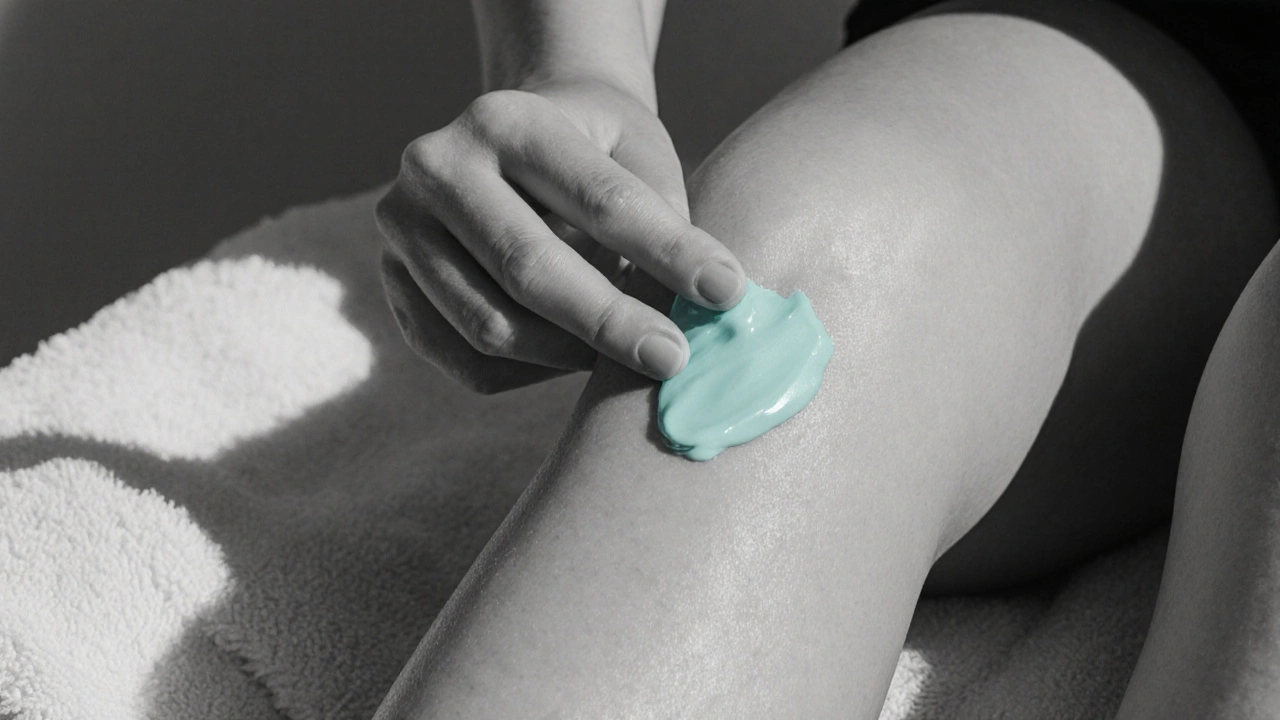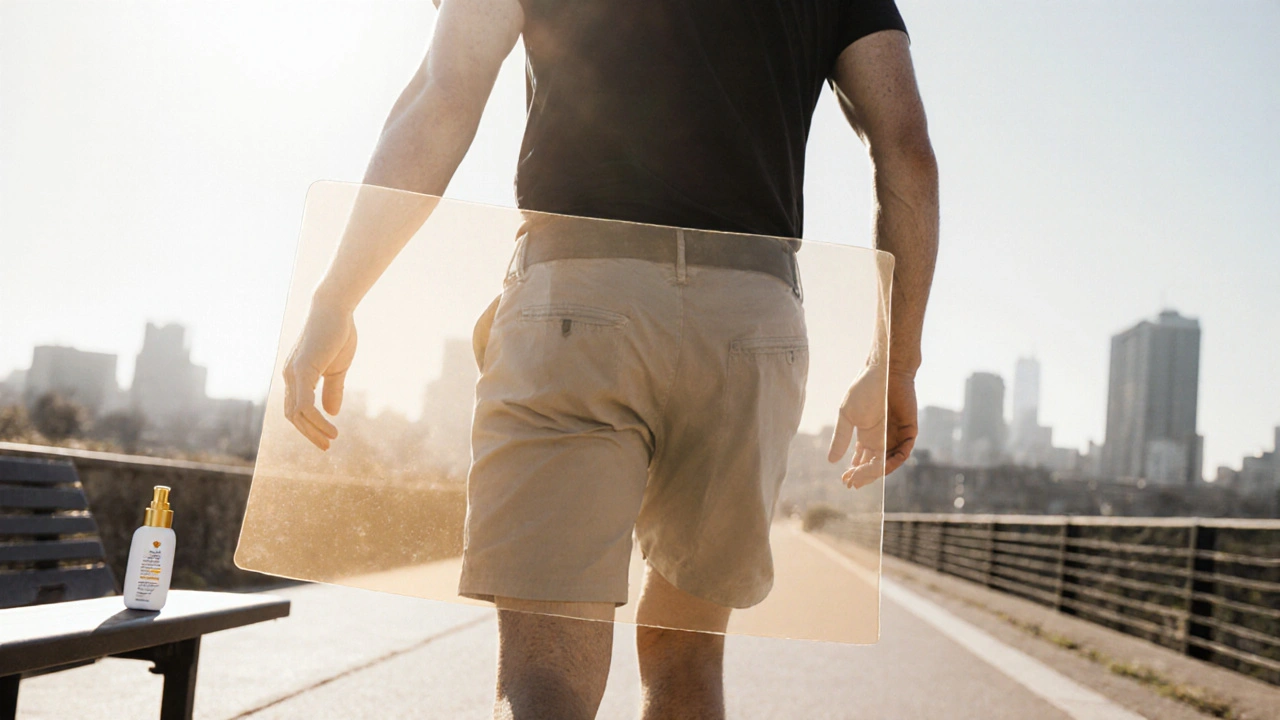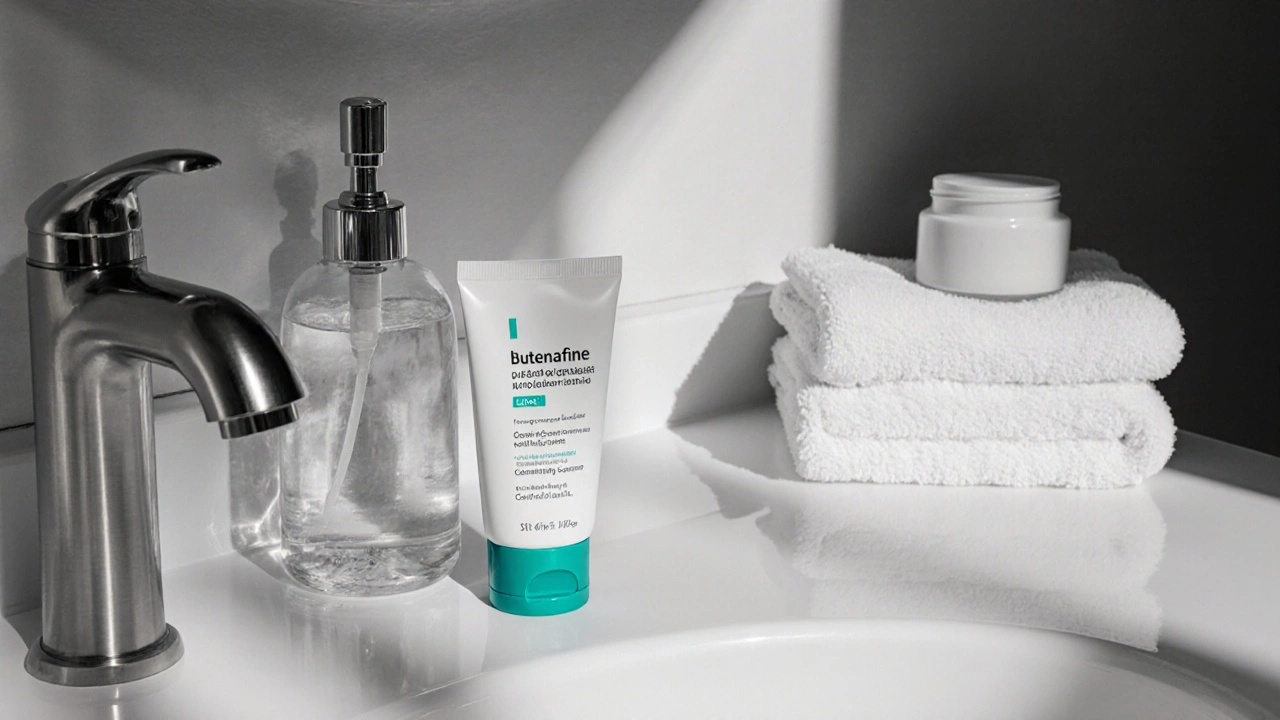Butenafine Treatment Duration Calculator
Recommended Treatment Plan
Most people think of antifungal meds as something you only use for athlete’s foot or a sudden rash, but you can actually weave butenafine into a regular skin‑care schedule without turning your bathroom into a pharmacy.
Key Takeaways
- Butenafine is a prescription‑strength antifungal that can be used safely once daily on clean, dry skin.
- Apply it after cleansing, before moisturizers and sunscreen, to let the active ingredient do its job.
- Watch for mild irritation; stop use and consult a dermatologist if symptoms persist.
- Combine butenafine with barrier‑supporting products (moisturizer, ceramide‑rich creams) for faster healing.
- Most side effects are mild and reversible, making it suitable for long‑term skin maintenance when fungal overgrowth is a recurring issue.
What Is Butenafine?
When you hear the name butenafine is a broad‑spectrum antifungal agent that targets dermatophytes, yeasts, and molds. It works by blocking the synthesis of ergosterol, a key component of fungal cell membranes, which essentially starves the fungus and stops it from spreading. The drug most often comes as a 1% cream, approved in many countries for conditions like athlete’s foot, jock itch, and ringworm.
Why Consider It for Daily Use?
Even if you don’t have an active infection, many people experience sub‑clinical fungal overgrowth that shows up as flaky patches, occasional itch, or a compromised skin barrier. Adding butenafine to your routine can act as a preventive shield, especially in humid climates or if you wear tight, moisture‑trapping clothing.
Think of it as a “maintenance dose” similar to how you might use a retinoid for anti‑aging. The key is to use it correctly, so you don’t waste the product or irritate the skin.
Step‑by‑Step: How to Incorporate Butenafine
- Cleanse. Start with a gentle, pH‑balanced cleanser. Rinse thoroughly and pat dry. Leaving moisture on the skin can dilute the cream’s effectiveness.
- Apply Butenafine. Using a pea‑sized amount, spread the antifungal cream over the target areas. For a full‑body routine, focus on zones prone to moisture - feet, groin, behind knees, and any patches that look red or scaly.
- Let It Absorb. Wait 3‑5 minutes before adding anything else. This short pause ensures the active ingredient penetrates the outer layer.
- Seal with Moisturizer. Choose a fragrance‑free, ceramide‑rich moisturizer. It helps restore the skin barrier and reduces the risk of dryness from the antifungal.
- Finish with Sunscreen (Daytime). If you’re stepping out, apply a broad‑spectrum sunscreen (SPF 30+). Sunscreen doesn’t interfere with butenafine, but it protects the newly repaired skin from UV‑induced irritation.
Doing this once in the morning is usually enough. If you’re treating an active infection, follow the doctor’s advice - many protocols suggest twice daily for the first week, then once daily for maintenance.

Choosing the Right Supporting Products
Not all moisturizers play nice with antifungals. Look for formulas that:
- Contain ceramides, cholesterol, and fatty acids - these rebuild the skin barrier.
- Are free of heavy fragrances, alcohol, or sodium lauryl sulfate, which can strip the cream away.
- Have a light, non‑occlusive texture so the antifungal can continue to breathe.
For sunscreen, a mineral‑based option (zinc oxide or titanium dioxide) is least likely to cause irritation under the cream.
Potential Side Effects and When to Stop
Butenafine is generally well‑tolerated. Reported reactions include mild redness, burning, or itching at the application site. These usually fade within a few days. If you notice any of the following, pause use and call a dermatologist:
- Persistent swelling or blistering.
- Severe itching that interferes with sleep.
- Signs of an allergic reaction - hives, swelling of lips or face.
Because the cream is a fungal infection treatment, stopping abruptly after a short course may allow the fungus to rebound. Follow the full prescribed duration unless advised otherwise.
Comparing Butenafine with Other Over‑the‑Counter Antifungals
| Attribute | Butenafine (1% cream) | Terbinafine (1% cream) | Clotrimazole (1% cream) |
|---|---|---|---|
| Broad‑spectrum coverage | Dermatophytes, yeasts, molds | Dermatophytes mainly | Yeasts & dermatophytes |
| Typical treatment length | 2‑4 weeks (maintenance possible) | 2‑4 weeks | 4‑6 weeks |
| Common side effects | Mild irritation, burning | Burning, itching | Redness, dryness |
| Prescription status (US) | Prescription‑only (often) | OTC | OTC |
| Cost (average 30‑day supply) | $30‑$45 | $15‑$20 | $12‑$18 |
While butenafine can be pricier, its broader coverage and shorter treatment window make it a solid choice for stubborn or recurring infections.

FAQs - Quick Answers
Frequently Asked Questions
Can I use butenafine on my face?
Yes, but only on areas with a confirmed fungal problem and after a dermatologist confirms it’s safe. The facial skin is thinner, so start with a very thin layer and watch for irritation.
How often should I re‑apply during the first week?
Most clinicians recommend twice daily (morning and night) until the first 3‑5 days, then switch to once‑daily for the remainder of the course.
Is it safe to combine butenafine with retinoids?
Both are active agents, so layering can increase irritation. If you use a retinoid at night, apply butenafine in the morning or wait at least 30 minutes between applications.
What should I do if I miss a dose?
Apply it as soon as you remember, unless it’s almost time for the next scheduled dose. In that case, skip the missed one and continue with your regular schedule.
Can butenafine be used on children?
Yes, pediatric use is approved for children older than 2 years, but dosage (cream amount) should be adjusted and a pediatrician consulted.
Next Steps and Troubleshooting
If you’ve followed the routine for two weeks and still see signs of infection, consider these actions:
- Double‑check that the skin is completely dry before application - moisture can block absorption.
- Swap to a higher‑potency prescription if over‑the‑counter options aren’t helping.
- Get a fungal culture from a dermatologist to identify the exact species; some molds require a different treatment.
- Review your footwear and clothing choices - fungi often thrive in tight, non‑breathing fabrics.
Remember, consistency is key. A well‑planned routine that respects the order of cleanse → butenafine → moisturizer → sunscreen not only treats existing issues but also builds a resilient barrier to keep future problems at bay.






Comments
Start by washing with a gentle, pH‑balanced cleanser, then pat the skin dry before you reach for the butenafine. A pea‑sized amount is enough – you don’t need to slather it on like a buttercream. Waiting a few minutes lets the medication soak in, and then you can lock in moisture with a ceramide‑rich cream. Consistency is key, so make it part of your morning routine and you’ll see the barrier get stronger over time.
Butenafine works by starving the fungus of ergosterol, which is like cutting off its food supply; without that, the pathogen can’t multiply. Even when you don’t see an active infection, sub‑clinical colonies can live on the skin’s surface, especially in humid spots like the groin or behind the knees. Applying a thin layer each morning creates a preventive shield that keeps those hidden spores at bay. The cream’s 1% concentration is strong enough to handle most dermatophytes, yeasts, and even some molds that other OTCs miss. Because it’s prescription‑only in the US, you’re more likely to get a product that’s been tested for consistency and purity. The key is to let the skin dry completely after cleansing; any residual water will dilute the active ingredient and reduce absorption. When you spread the cream, use a gentle patting motion rather than rubbing, which can irritate sensitive areas. After the antifungal has had three to five minutes to sink in, follow up with a fragrance‑free moisturizer that contains ceramides, cholesterol, and fatty acids. Those lipids help rebuild the barrier that the fungus would otherwise exploit. If you’re heading outdoors, a mineral‑based sunscreen with zinc oxide won’t interfere with the medication and will protect the newly repaired skin from UV‑induced inflammation. Most users report only mild redness or a brief tingling sensation, which usually disappears within a few days. However, if you notice persistent burning, swelling, or blistering, stop the treatment and talk to a dermatologist right away. It’s also wise to keep an eye on your footwear and apparel – tight, non‑breathing fabrics are a breeding ground for fungi. Swapping to breathable socks and shoes can dramatically cut down on re‑infection risk. Finally, remember that consistency beats intensity; once‑daily application for a few weeks is often enough to keep the fungal population under control without over‑loading your skin. Stick to the schedule and you’ll avoid the temptation to over‑apply, which can cause unnecessary irritation.
It smells like a pharma push to get us hooked on a pricey prescription rather than encouraging natural barrier repair; the studies cited are often funded by the same companies that sell the cream.
Make sure the moisturizer you pick is non‑comedogenic so it won’t clog pores while still supplying the skin with essential lipids.
Our own traditional remedies have kept skin healthy for centuries; relying on imported chemicals like butenafine is just another way for foreign corporations to profit from our health.
Just stick to the routine and you’ll be golden!
Think of the skin as a community – every layer supports the others, and introducing a targeted antifungal is like assigning a guard to patrol the borders while the moisturizers act as diplomats building peace.